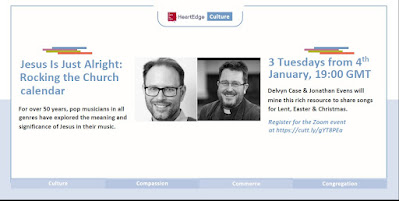In 1935, Lutheran pastor
Dietrich Bonhoeffer accepted an invitation from the confessing church in Germany to direct an underground seminary that would recover their rich Christian tradition and train a new generation of church leaders in practice and belief.
The
seminary at Finkenwalde became a social experiment in intentional Christian community modelled on the Sermon on the Mount, “a sort of new monasticism.” Bonhoeffer’s book ‘Life Together’ gives the details for anyone interested in finding out more. In practice the seminary lasted but a moment; the Gestapo, the secret state police, closed the seminary in 1937 and arrested more than two dozen of its students. Bonhoeffer was also arrested in 1943 and executed in 1945, just weeks before the end of World War II.
Following the closure of the seminary, Bonhoeffer wrote circular letters to the disbanded seminarians of Finkenwalde. In the first letter, he wrote that 27 members of the group had spent time in prison. Bonhoeffer speaks in the letter of a “time of testing for us all” and implores his students not to allow their physical separation to result in their isolation from one another. A major theme of Bonhoeffer’s correspondence to the seminarians was a summons to pursue and maintain fellowship with one another in any and every way possible.
In his letters Bonhoeffer was not simply concerned to support and connect the seminarians. He also wanted to continue their theological reflection, particularly in relation to the question of who Jesus Christ is for us today. Christmas, he thought, was the key to answering that question. His view was that all the theology of the ancient church about Jesus “really arose at the cradle of Bethlehem”, and so “the brightness of Christmas lies on its weather-beaten face”. Even today, he wrote, “it wins the hearts of all who come to know it”. So, “at Christmas time we should again go to school with the ancient church and seek to understand in worship what it thought and taught, to glorify and to defend belief in Christ.”
In a letter sent at Christmas 1939, he wrote:
“No priest, no theologian stood at the cradle in Bethlehem. And yet all Christian theology has its origin in the wonder of all wonders, that God became [hu]man … Theologia sacra arises from those on bended knees who do homage to the mystery of the divine child in the stall. Israel had no theology. She did not know God in the flesh. Without the holy night there is no theology. God revealed in the flesh, the God-[hu]man Jesus Christ, is the holy mystery which theology is appointed to guard.
What a mistake to think that it is the task of theology to unravel God’s mystery, to bring it down to the flat, ordinary human wisdom of experience and reason! It is the task of theology solely to preserve God’s wonder as wonder, to understand, to defend, to glorify God’s mystery as mystery.”
That is what we are here to do together tonight; to glorify the mystery of God revealed in the flesh.
So, what can we say is going on here, where Mary becomes the mother of God, where God comes into the world in the lowliness of the manger, where pious shepherds are on their knees, and where kings bring their gifts? Bonhoeffer says that because God is in the manger, “God is near to lowliness” and “loves the lost, the neglected, the unseemly, the excluded, the weak and broken.”
That is the unrecognized mystery of this world: Jesus Christ as God with us. “God as the one who becomes low for our sakes, God in Jesus … that is the secret, hidden wisdom… that “no eye has seen, nor ear heard, nor the human heart conceived” (1 Cor. 2:9).” It is a redemptive mystery “because God became poor, low, lowly, and weak out of love for humankind, because God became a human being like us, so that we would become divine, and because he came to us so that we would come to him”. It is also a mystery of judgment because the Christ child in the manger “pushes back the high and mighty; he overturns the thrones of the powerful; he humbles the haughty; his arm exercises power over all the high and mighty; he lifts what is lowly, and makes it great and glorious in his mercy.”
In a letter sent out at Christmas 1939 Bonhoeffer wrote about the nativity ''The body of Jesus Christ is our flesh. He bears our flesh. Therefore, where Jesus Christ is, there we are, whether we know it or not; that is true because of the incarnation. What happens to Jesus Christ, happens to us. It really is all our "poor flesh and blood" which lies there in the crib; it is our flesh which dies with him on the cross and is buried with him. He took human nature so that we might be eternally with him. Where the body of Jesus Christ is, there we are; indeed, we are his body. So the Christmas message for all … runs: You are accepted. God has not despised you, but he bears in his body all your flesh and blood. Look at the cradle! In the body of the little child, in the incarnate son of God, your flesh, all your distress, anxiety, temptation, indeed all your sin, is borne, forgiven and healed."
In a later Advent letter, he wrote:
“The joy of God goes through the poverty of the manger and the agony of the cross; that is why it is invincible, irrefutable. It does not deny the anguish, when it is there, but finds God in the midst of it, in fact precisely there; it does not deny grave sin but finds forgiveness precisely in this way; it looks death straight in the eye, but it finds life precisely within it.”
If we want to understand this mystery, find God and forgiveness in the midst of anguish, look death straight in the eye and find life within it, then we must participate in the Christmas event, “we cannot simply sit there like spectators in a theatre and enjoy all the friendly pictures”. “Rather, we must join in the action that is taking place and be drawn into this reversal of all things ourselves.”
The 17th century German mystic,
Angelus Silesius, warned:
“Though Christ a thousand times / In Bethlehem be born / If he’s not born in thee, / Thou art still forlorn.”
Ricky Ross, the lead singer of
Deacon Blue, wrote:
“You got to go back, gotta go back, gotta go back in time / To Bethlehem / To begin again.”
This Christmas begin again by looking in the cradle to see not only Jesus, but also yourself. That is the great insight of Bonhoeffer’s letters; where Jesus Christ is, there we are, whether we know it or not; what happens to Jesus Christ, happens to us. He became a human being like us, so that we would become divine. He came to us so that we would come to him. He took human nature so that we might be eternally with him. Where the body of Jesus Christ is, there we are; indeed, we are his body. Like new parents seeing their new-born child for the first time and recognising their features in their child, so, when we look in the manger, we see ourselves looking back at us.
“How shall we deal with such a child?” Bonhoeffer asks. “Have our hands, soiled with daily toil, become too hard and too proud to fold in prayer at the sight of this child? Has our head become too full of serious thoughts … that we cannot bow our head in humility at the wonder of this child? Can we not forget all our stress and struggles, our sense of importance, and for once worship the child, as did the shepherds and the wise men from the East, bowing before the divine child in the manger like children?”
This Christmas, go back in time to begin again. Amen.
-----------------------------------------------------------------------------------------------------------









